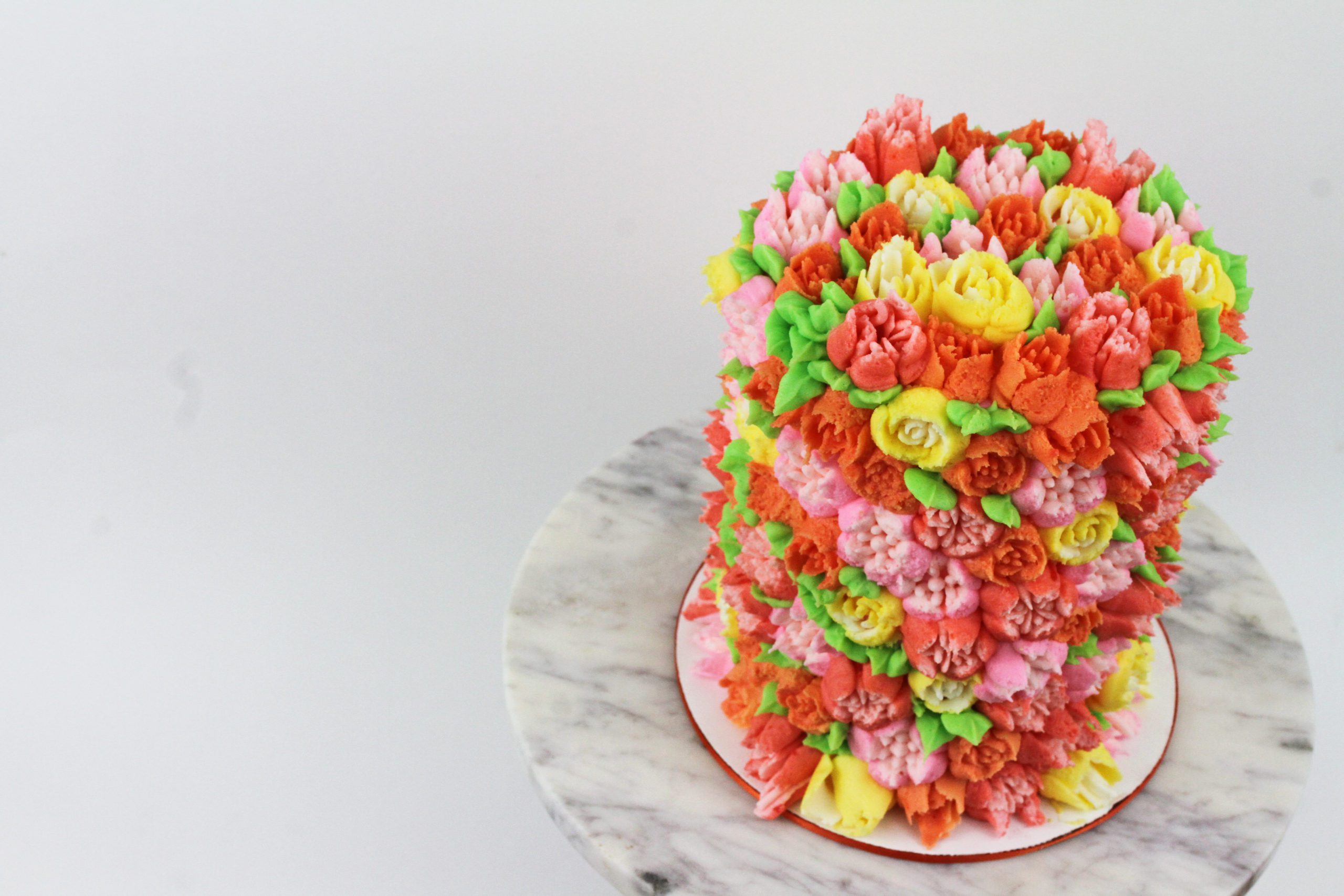
In this tutorial I’m going to show you how to use these elaborate looking flower tips, which are also called Russian tips. With just one squeeze of a piping bag you can create these intricate flowers that make stunning decorations for cakes or cupcakes. They look complicated but they’re actually very easy to use with just a few tricks, which I’m going to show you now.
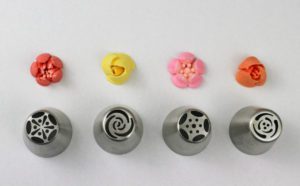
Trick #1: How to get the buttercream consistency just right
If you’re making a fresh batch of buttercream using my 4 Minute Buttercream recipe, leave out the milk or cream and the frosting should be the perfect consistency for these tips. If you’ve already added milk or cream because you’re going to use the buttercream to frost a cake, add a little bit more powdered sugar to thicken it up. You’ll get used to recognizing the consistency: buttercream is too thick if it’s quite difficult to stir and when you lift your spatula, the peak of buttercream it leaves behind is very rough and jagged, like in this photo.
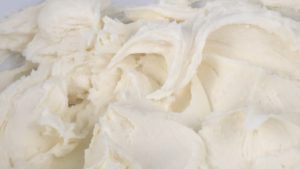
When the buttercream is too stiff it will cling to your piping tip and not all of the petals will release when you squeeze the piping bag so you’ll get uneven rough edges on the petals like this:
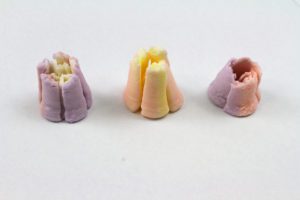
or hollow flowers because the details in the middle of the flower will cling to the piping tip and lift off with it, like in these test flowers.
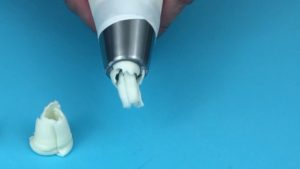
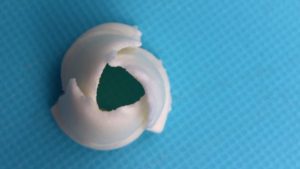
If your buttercream is too stiff, add a bit of milk. If it’s too soft, so the flowers are coming out with their petals mushed together and undefined, just add a bit more sugar. Test the buttercream before you add your colours because otherwise you’ll have to check and potentially change the consistency of every bowl of each separate colour.
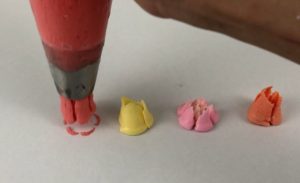
Trick #2: How to prepare and fill your piping bags
Flower tips or Russian tips are bigger than standard tips so they probably won’t put into the piping bags you already have. To make them fit, drop them into a piping bag and use a pair of scissors to score around just above the tip of the tip.
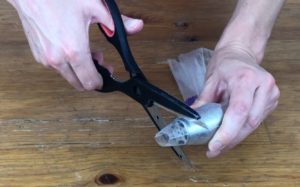

When you take the tip out you’ll see a line behind and you can cut along that and then when you drop the tip in, it should go in with just the tip of the tip sticking out.
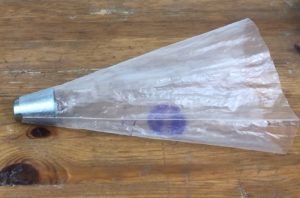

Before you fill your bag with buttercream, divide your buttercream into separate bowls and add colour to each one. I like to use gel food colours because they’re a lot thicker than liquid colours so they won’t affect the consistency of your buttercream. You don’t have to mix your colours in completely – they look quite nice when they’re blended.


Part of the fun of these tips is that it’s so easy to incorporate lots of colours. There are a few methods to fill up the bags and for this first one you’re going to need a tall glass. Insert the piping bag into the glass with the tip at the bottom and fold the top of the piping bag over the rim of the glass and pull it down until the bag is quite tight inside the glass. For more tips and tricks like this, check out my tutorial on 10 Hacks For Decorating Cakes Like A Pro.
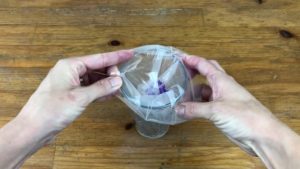

Spread the first colour of buttercream around the outside of the bag. I like to use an offset spatula for this but you could also use a regular spatula or spoon or even a knife and if you want to.
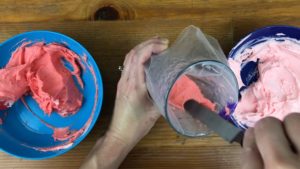

You can do a few different layers of colour with a different colour layered on top of each one so that the colours blend gradually from a dark to a light colour. If you look at flowers you’ll notice that usually the colour on the outer petals is much darker than on inner petals or the little details on the inside of the flowers so that’s how I like to do my buttercream as well.
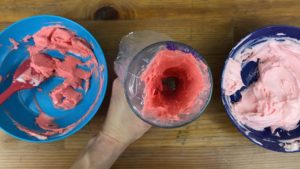

Once you’ve got your layer of frosting all around the piping bag, add another colour inside. You can push it in with a spatula, but it’s quite difficult to get all the way down to the bottom.
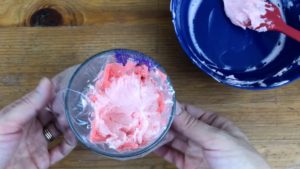

If the inner colour frosting sits a little bit higher in the bag than the outer colour of frosting, when you squeeze the bag you might see only the outside colour coming out for a while but just wipe it off on one of your frosting bowls and as soon as the inside colour starts coming through, the bag is ready to go.
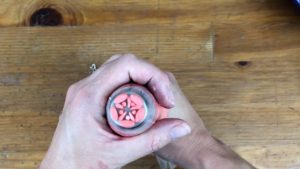

To get the inside colour further down in the bag so that when you pipe both colours come out straight away, after spreading the first colour around the sides of the bag you can use a piping bag without a tip, pushing the piping bag down as low as you can in the bag before you start squeezing and this way you should have both colours all the way down at the bottom of the bag.
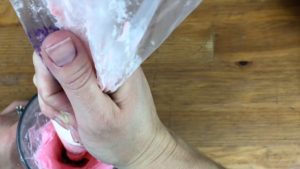

If this looks a bit fiddly, another technique is to use cling film or saran wrap to separate your colours. Spread the first colour in a rectangular block in the middle of the cling film. This is going to be the colour on the outside of the flower.
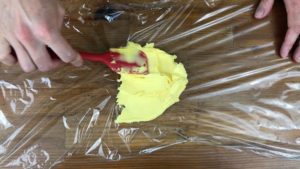

Spread or pipe the next colour down the middle, and this will be the colour in the middle of the flower.
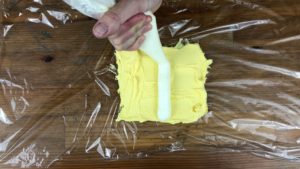

Fold the buttercream over itself using the plastic wrap to help you roll it up into a log of buttercream.
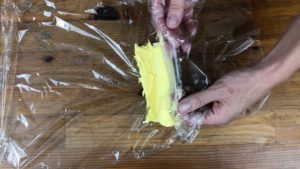

Cut one of the ends off and then push that end down into the bottom of one of your piping bags.
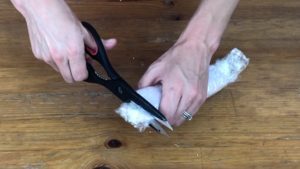

The easiest way to mix colours is to spoon them all randomly into the piping bag or you can put them in a bowl and stir them just a little bit to blend them slightly and then spoon them into the bag. You don’t have much control of how the colours come out this way but for some flowers it looks really pretty when they’re a bit random like this.
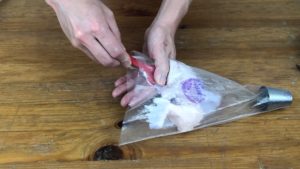

These bags don’t look very full but this is enough to completely cover a very tall 4-inch cake with flowers. It’s only just over one cup of buttercream so you don’t need as much as you think for this.
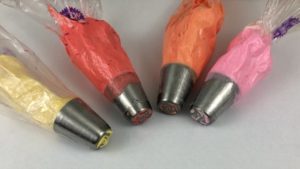

Trick #3: How to prepare your cake
When you frost your cake, choose a complementary colour for the frosting just in case any of the frosting is visible. If you’re going to be piping leaves you could choose green so that any frosting showing through in between flowers just looks like more leaves.
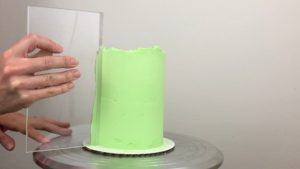

For this cake I’m using pink because most of the flowers have pinkish tones so any visible frosting will hopefully look like it’s just part of one of these flowers.
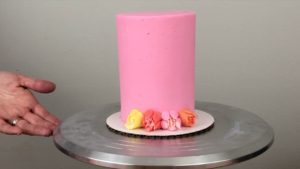

Optionally, you can chill your cake so that the frosting sets and becomes hard and the advantage of this is that if you pipe a flower you don’t like, you can scrape it off. Because the frosting on the cake is hard it won’t get indented or smudged by the flower you’re scraping off or by your offset spatula.
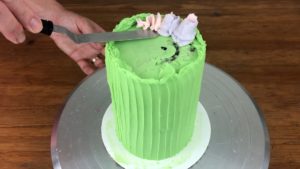

If the flowers pull off the cake as you pipe them, it could be because of two things. The first is that your frosting consistency is too stiff so the frosting doesn’t want to leave the piping bag, so it clings to the piping tip instead of transferring to the cake.
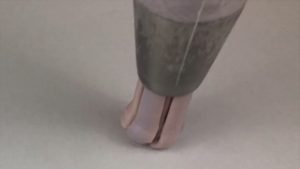

Another reason for flowers not sticking to the cake is because the surface you’re piping onto isn’t sticky enough so the flower doesn’t have anything to cling to. Crusting buttercream loses its stickiness when it sets, which happens either when you put it in the fridge or just by sitting out for about 20 minutes. This is useful for most decorating techniques but if it’s preventing your flowers from sticking to the cake, you can spread a thin layer of frosting onto the cake on top of the frosting that’s already there and that way the flowers will have something to stick to.
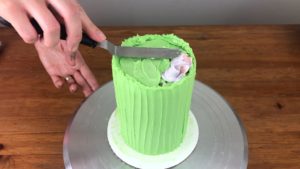

Trick #4: How to perfect your piping technique
You should always do a test first on parchment paper or a paper towel or a baking tray or whatever you have handy before you actually get started on the cake. Every batch of buttercream is going to have a slightly different consistency and this is exaggerated by the temperature of the ingredients you use and also the weather that day, so buttercream will pipe slightly differently every time you do it.



When you want the flower to end you need to lift the piping bag up and immediately after you start lifting your hand to release the pressure on the bag and that will give your petals a nice neat point. You’ll find that some flowers look better piped quite short and others look better with longer petals so you can play around with the height of the flowers too.
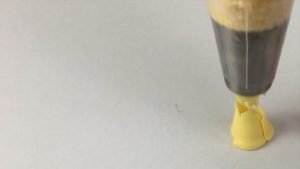

The technique for piping against the side of the cake is the same, it’s just at a different angle so it might take a little bit of getting used to. Assuming your buttercream is at the right consistency, if the flower buckles at the bottom so it has little ridges or or waves at the base, you need to lift your wrist a bit faster because what’s happening is the buttercream is coming out faster than your movement. If your petals are breaking off early you need to apply more pressure to the piping bag because you’re lifting the bag faster than you’re piping the buttercream.
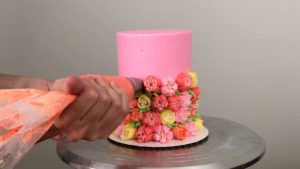

As you pipe, your hands will warm up the buttercream in the piping bag so your petals might start to lose their shape. The petals of this orange flower has mushed together and lost their definition because the buttercream is too soft.
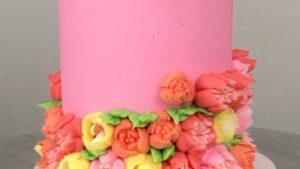

You can put the piping bag in the freezer for one minute to chill the buttercream (set a timer so you don’t forget about it!) and then squeeze out a practice flower or two to check the consistency and when you’re happy with the flowers you can continue on your cake.
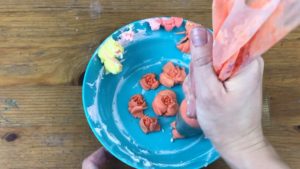

Trick #5: Add finishing touches
Leaves are a fantastic finishing touch. Adding some greenery to your flowers will mimic how they look in nature. It adds more colour to your cake, it fills in any gaps between flowers where you can see the frosting of the cake underneath, and you can also use it to cover up any parts of a flower you don’t like, like if there’s a ridge at the base of the flower.
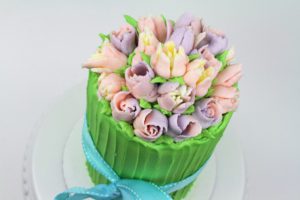

This is a leaf tip and you should hold it this way, sideways, so that you can see a triangle on the side of the tip. When you pipe you are first creating the base of the leaf and as you pull your wrist away and release the pressure on the piping bag, you’re creating the point of the leaf.
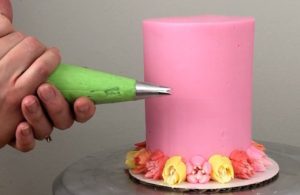

You can pipe leaves after you finish each row or section of flowers and that’s a nice way to do it because you have a very good view of the cake at that point.
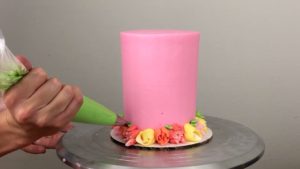

Alternatively, you can continue piping more flowers and then go in and fill in the gaps. This is more efficient, with less changing between piping bags, but it’s a bit more difficult to see what’s going on – you have to crouch down to see where the gaps are.
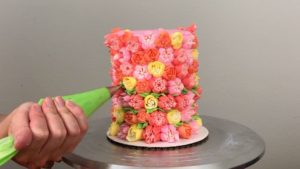

Leaves are particularly useful at the top edge of a cake in places where a full flower won’t fit – piping flowers onto that 90 degree angle at the corner of the top of the cake is quite tricky! Instead, you can pipe a few leaves and that fills in the gap and then you can pipe your next flower onto a flat surface instead of a corner.
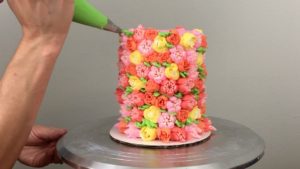

A fun idea to add some colour after you’ve decorated your cake is to add ribbon. You can choose a ribbon that adds more colour to the cake or one that matches the flowers you’ve already picked. It’s really important to chill your cake properly first so you should put it in the fridge for at least an hour so the frosting sets and gets hard. Wrap your ribbon around the cake and tie it in a bow.
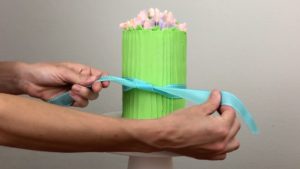

If you want to secure the ribbon onto the cake you can put a little dab of buttercream in between the ribbon and the cake and that will set the ribbon in the right place.
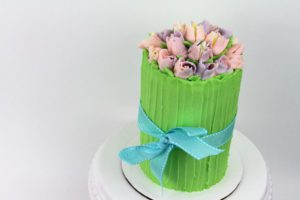

These flower tips might look intimidating at first but I hope this tutorial has given you some useful tricks and confidence to use them. I’d love to see your cakes – please tag @britishgirlbakes in your photos on Instagram so I can see them!
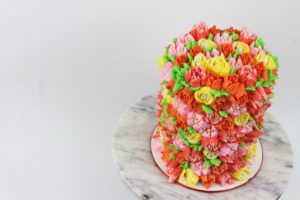

If you prefer to watch a video of this tutorial, click the play button below:


Hello, I love your online tutorials only I’m really having trouble with my Russian nozzle flowers! I do everything that you say to correct this only after the first flower..each flower has no stamens and outer leaves are floppy it’s as if both issues happen to the same flower ie, too stiff/too soft ? Buttercream recipe using butter, icing sugar, gel paste sometimes milk...please where am I going wrong?